这一节跟上一节用户微服务的注册方式是类似的,这一节主要会有个jpa一对多单向关联保存和查询的知识点,其他的操作也都很相似,相当于在复习一遍了
订单微服务主要是用户订单数据的保存以及订单明细的保存,包括订单金额,订单状态等等
目录
1、创建订单数据库和表结构
这里需要注意的是,创建表名最好加前缀,由于order是order by的关键字,也是mysql的保留关键字,如果直接用order命名查询不是很方便,还需要用单引号包裹,表名和表字段最好都用前缀来区分会好一点。
create schema cloud_order collate utf8mb4_0900_ai_ci; create table c_order ( id char(32) not null, order_no varchar(50) not null comment '订单号', order_status char default '0' not null comment '0 创建 1 完成 2 删除', finish_date datetime null comment '完成日期', delete_date datetime null comment '删除日期', create_date datetime not null, create_by char(32) not null, update_date datetime not null, update_by char(32) not null, amount double not null, constraint order_id_uindex unique (id) ) comment '订单'; alter table c_order add primary key (id); create table c_order_detail ( id char(32) not null, order_id char(32) null comment '订单id', good_id char(32) not null comment '商品ID', good_name varchar(50) not null comment '商品名称', price double not null comment '商品价格', quantity int not null comment '商品数量', amount double null comment '总金额', create_date datetime not null, create_by char(32) not null, update_date datetime not null, update_by char(32) null, constraint order_detail_id_uindex unique (id), constraint c_order_detail_c_order_id_fk foreign key (order_id) references c_order (id) on update cascade on delete cascade ) comment '订单明细'; alter table c_order_detail add primary key (id);
2、新建cloud-order订单微服务子模块
新建方法同上节类似,这里不再赘述
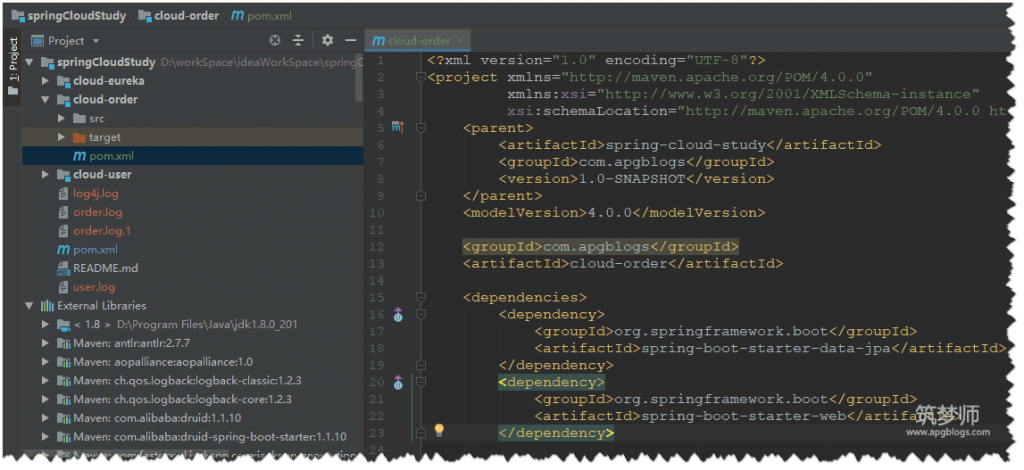
3、pom.xml文件中添加需要依赖的jar包
<?xml version="1.0" encoding="UTF-8"?>
<project xmlns="http://maven.apache.org/POM/4.0.0"
xmlns:xsi="http://www.w3.org/2001/XMLSchema-instance"
xsi:schemaLocation="http://maven.apache.org/POM/4.0.0 http://maven.apache.org/xsd/maven-4.0.0.xsd">
<parent>
<artifactId>spring-cloud-study</artifactId>
<groupId>com.apgblogs</groupId>
<version>1.0-SNAPSHOT</version>
</parent>
<modelVersion>4.0.0</modelVersion>
<groupId>com.apgblogs</groupId>
<artifactId>cloud-order</artifactId>
<dependencies>
<dependency>
<groupId>org.springframework.boot</groupId>
<artifactId>spring-boot-starter-data-jpa</artifactId>
</dependency>
<dependency>
<groupId>org.springframework.boot</groupId>
<artifactId>spring-boot-starter-web</artifactId>
</dependency>
<dependency>
<groupId>mysql</groupId>
<artifactId>mysql-connector-java</artifactId>
<scope>runtime</scope>
</dependency>
<dependency>
<groupId>org.springframework.boot</groupId>
<artifactId>spring-boot-starter-test</artifactId>
<scope>test</scope>
</dependency>
<!-- 数据库连接池 -->
<dependency>
<groupId>com.alibaba</groupId>
<artifactId>druid-spring-boot-starter</artifactId>
<version>1.1.10</version>
</dependency>
<dependency>
<groupId>log4j</groupId>
<artifactId>log4j</artifactId>
<version>1.2.17</version>
</dependency>
<dependency>
<groupId>com.google.code.gson</groupId>
<artifactId>gson</artifactId>
<version>2.8.5</version>
</dependency>
<!--服务客户端 -->
<dependency>
<groupId>org.springframework.cloud</groupId>
<artifactId>spring-cloud-starter-netflix-eureka-client</artifactId>
</dependency>
</dependencies>
</project>
4、创建配置文件
application.yml
这个文件需要修改的是应用名,改为cloud-order,这个名字将显示在服务注册中心页面中
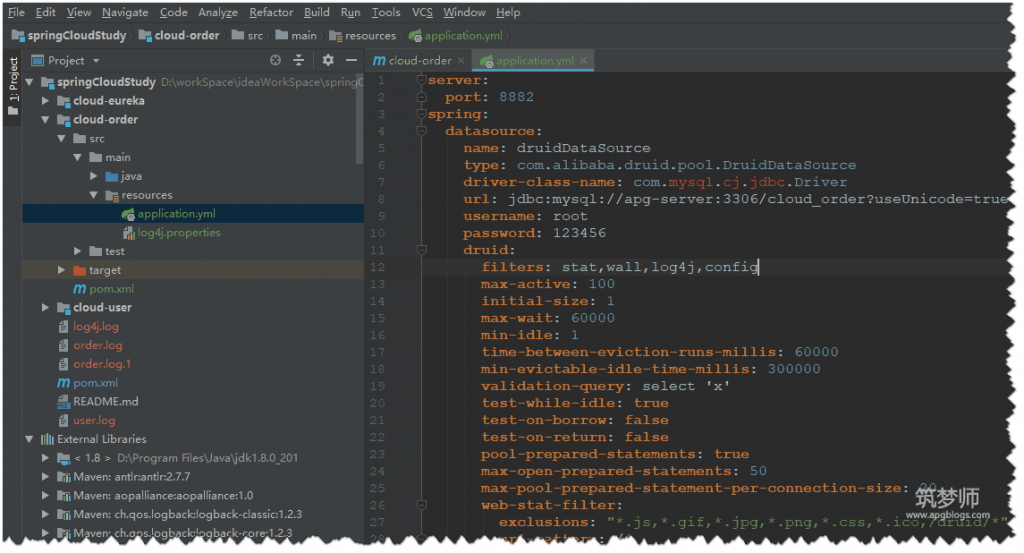
log4j.properties
这个文件也是修改下日志文件名,这里日志文件名并没有指定一个好的路径,这个在后面会专门集成日志服务处理,所以不用担心
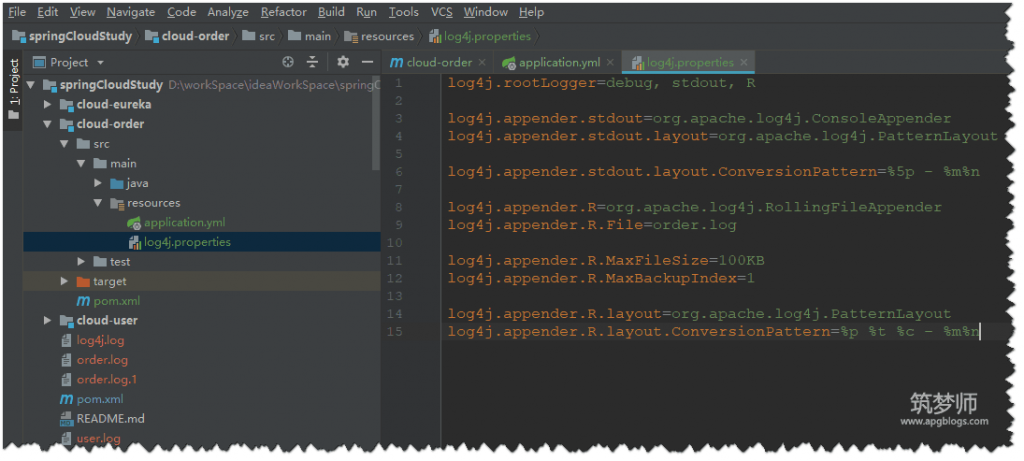
5、创建controller,entity,repository,service等包和相应的类
包的创建方式和上一节是一样的,这里就不说了
下图是包结构
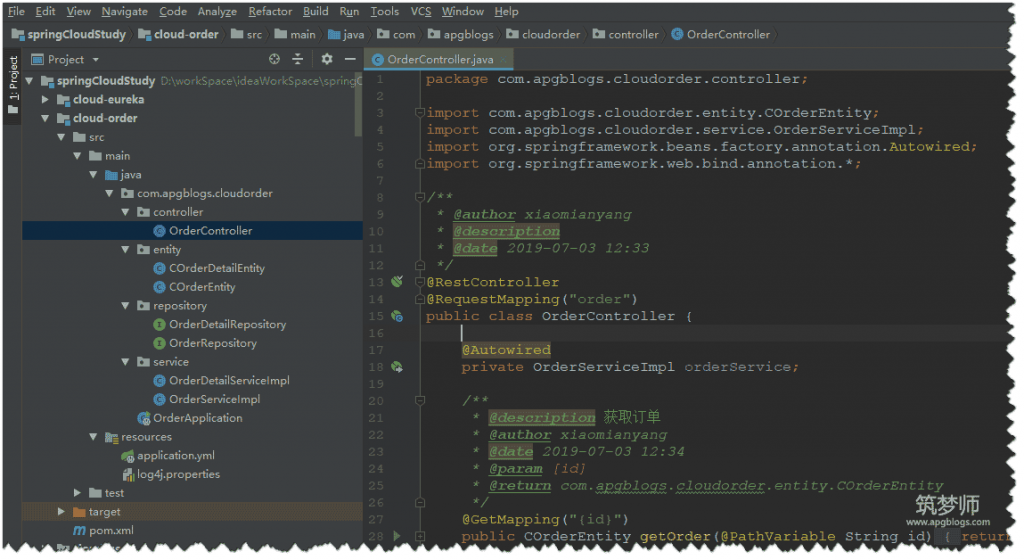
COrderEntity
订单实体类,采用一对多的方式关联订单明细
这里需要注意的是采用的单向一对多关联,所以在订单明细表中是有个外键order_id进行关联的,这个字段在数据库中不要设置成不能为空,不然jpa保存时会报错提示order_id不能为空。
@OneToMany(targetEntity = COrderDetailEntity.class,cascade = CascadeType.ALL)
一对多关联,targetEntity表示子类也就是多数据的那一方,可以不用写,默认就是注解下面的订单明细类,后面 CascadeType 级联操作,这里选择所有操作
@JoinColumn(name="order_id")
关联的外键字段,也就是订单明细表中order_id,这个字段不能设置为不为空,不然无法正常保存,jpa应该是先保存两个表的数据,然后根据关联关系在单独修改子明细的order_id列
package com.apgblogs.cloudorder.entity;
import org.hibernate.annotations.GenericGenerator;
import org.springframework.data.annotation.CreatedDate;
import org.springframework.data.annotation.LastModifiedDate;
import org.springframework.data.jpa.domain.support.AuditingEntityListener;
import javax.persistence.*;
import java.sql.Timestamp;
import java.util.HashSet;
import java.util.List;
import java.util.Objects;
import java.util.Set;
/**
* @author xiaomianyang
* @description
* @date 2019-07-03 11:26
*/
@Entity
@Table(name = "c_order", schema = "cloud_order", catalog = "")
@EntityListeners(AuditingEntityListener.class)
public class COrderEntity {
private String id;
private String orderNo;
private String orderStatus="0";
private Timestamp finishDate;
private Timestamp deleteDate;
private Timestamp createDate;
private String createBy="sys";
private Timestamp updateDate;
private String updateBy="sys";
private double amount;
private List<COrderDetailEntity> cOrderDetailEntityList;
@Id
@Column(name = "id", nullable = false, length = 32)
@GenericGenerator(name = "jpa-uuid", strategy = "uuid")
@GeneratedValue(generator = "jpa-uuid")
public String getId() {
return id;
}
public void setId(String id) {
this.id = id;
}
@Basic
@Column(name = "order_no", nullable = false, length = 50)
public String getOrderNo() {
return orderNo;
}
public void setOrderNo(String orderNo) {
this.orderNo = orderNo;
}
@Basic
@Column(name = "order_status", nullable = false, length = 1)
public String getOrderStatus() {
return orderStatus;
}
public void setOrderStatus(String orderStatus) {
this.orderStatus = orderStatus;
}
@Basic
@Column(name = "finish_date", nullable = false)
public Timestamp getFinishDate() {
return finishDate;
}
public void setFinishDate(Timestamp finishDate) {
this.finishDate = finishDate;
}
@Basic
@Column(name = "delete_date", nullable = true)
public Timestamp getDeleteDate() {
return deleteDate;
}
public void setDeleteDate(Timestamp deleteDate) {
this.deleteDate = deleteDate;
}
@Basic
@Column(name = "create_date", nullable = false)
@CreatedDate
public Timestamp getCreateDate() {
return createDate;
}
public void setCreateDate(Timestamp createDate) {
this.createDate = createDate;
}
@Basic
@Column(name = "create_by", nullable = false, length = 32)
public String getCreateBy() {
return createBy;
}
public void setCreateBy(String createBy) {
this.createBy = createBy;
}
@Basic
@Column(name = "update_date", nullable = false)
@LastModifiedDate
public Timestamp getUpdateDate() {
return updateDate;
}
public void setUpdateDate(Timestamp updateDate) {
this.updateDate = updateDate;
}
@Basic
@Column(name = "update_by", nullable = false, length = 32)
public String getUpdateBy() {
return updateBy;
}
public void setUpdateBy(String updateBy) {
this.updateBy = updateBy;
}
@Basic
@Column(name = "amount", nullable = false, precision = 0)
public double getAmount() {
return amount;
}
public void setAmount(double amount) {
this.amount = amount;
}
@OneToMany(targetEntity = COrderDetailEntity.class,cascade = CascadeType.ALL)
@JoinColumn(name="order_id")
public List<COrderDetailEntity> getcOrderDetailEntityList() {
return cOrderDetailEntityList;
}
public void setcOrderDetailEntityList(List<COrderDetailEntity> cOrderDetailEntityList) {
this.cOrderDetailEntityList = cOrderDetailEntityList;
}
@Override
public boolean equals(Object o) {
if (this == o) return true;
if (o == null || getClass() != o.getClass()) return false;
COrderEntity that = (COrderEntity) o;
return Double.compare(that.amount, amount) == 0 &&
Objects.equals(id, that.id) &&
Objects.equals(orderNo, that.orderNo) &&
Objects.equals(orderStatus, that.orderStatus) &&
Objects.equals(finishDate, that.finishDate) &&
Objects.equals(deleteDate, that.deleteDate) &&
Objects.equals(createDate, that.createDate) &&
Objects.equals(createBy, that.createBy) &&
Objects.equals(updateDate, that.updateDate) &&
Objects.equals(updateBy, that.updateBy);
}
@Override
public int hashCode() {
return Objects.hash(id, orderNo, orderStatus, finishDate, deleteDate, createDate, createBy, updateDate, updateBy, amount);
}
}
COrderDetailEntity
订单明细类
package com.apgblogs.cloudorder.entity;
import org.hibernate.annotations.GenericGenerator;
import org.springframework.data.annotation.CreatedDate;
import org.springframework.data.annotation.LastModifiedDate;
import org.springframework.data.jpa.domain.support.AuditingEntityListener;
import javax.persistence.*;
import java.sql.Timestamp;
import java.util.Objects;
/**
* @author xiaomianyang
* @description
* @date 2019-07-03 11:26
*/
@Entity
@Table(name = "c_order_detail", schema = "cloud_order", catalog = "")
@EntityListeners(AuditingEntityListener.class)
public class COrderDetailEntity {
private String id;
private String orderId;
private String goodId;
private String goodName;
private double price;
private int quantity;
private Double amount;
private Timestamp createDate;
private String createBy="sys";
private Timestamp updateDate;
private String updateBy="sys";
@Id
@Column(name = "id", nullable = false, length = 32)
@GenericGenerator(name = "jpa-uuid", strategy = "uuid")
@GeneratedValue(generator = "jpa-uuid")
public String getId() {
return id;
}
public void setId(String id) {
this.id = id;
}
@Basic
@Column(name = "order_id", length = 32)
public String getOrderId() {
return orderId;
}
public void setOrderId(String orderId) {
this.orderId = orderId;
}
@Basic
@Column(name = "good_id", nullable = false, length = 32)
public String getGoodId() {
return goodId;
}
public void setGoodId(String goodId) {
this.goodId = goodId;
}
@Basic
@Column(name = "good_name", nullable = false, length = 50)
public String getGoodName() {
return goodName;
}
public void setGoodName(String goodName) {
this.goodName = goodName;
}
@Basic
@Column(name = "price", nullable = false, precision = 0)
public double getPrice() {
return price;
}
public void setPrice(double price) {
this.price = price;
}
@Basic
@Column(name = "quantity", nullable = false)
public int getQuantity() {
return quantity;
}
public void setQuantity(int quantity) {
this.quantity = quantity;
}
@Basic
@Column(name = "amount", nullable = true, precision = 0)
public Double getAmount() {
return amount;
}
public void setAmount(Double amount) {
this.amount = amount;
}
@Basic
@Column(name = "create_date", nullable = false)
@CreatedDate
public Timestamp getCreateDate() {
return createDate;
}
public void setCreateDate(Timestamp createDate) {
this.createDate = createDate;
}
@Basic
@Column(name = "create_by", nullable = false, length = 32)
public String getCreateBy() {
return createBy;
}
public void setCreateBy(String createBy) {
this.createBy = createBy;
}
@Basic
@Column(name = "update_date", nullable = false)
@LastModifiedDate
public Timestamp getUpdateDate() {
return updateDate;
}
public void setUpdateDate(Timestamp updateDate) {
this.updateDate = updateDate;
}
@Basic
@Column(name = "update_by", nullable = true, length = 32)
public String getUpdateBy() {
return updateBy;
}
public void setUpdateBy(String updateBy) {
this.updateBy = updateBy;
}
@Override
public boolean equals(Object o) {
if (this == o) return true;
if (o == null || getClass() != o.getClass()) return false;
COrderDetailEntity that = (COrderDetailEntity) o;
return Double.compare(that.price, price) == 0 &&
quantity == that.quantity &&
Objects.equals(id, that.id) &&
Objects.equals(orderId, that.orderId) &&
Objects.equals(goodId, that.goodId) &&
Objects.equals(goodName, that.goodName) &&
Objects.equals(amount, that.amount) &&
Objects.equals(createDate, that.createDate) &&
Objects.equals(createBy, that.createBy) &&
Objects.equals(updateDate, that.updateDate) &&
Objects.equals(updateBy, that.updateBy);
}
@Override
public int hashCode() {
return Objects.hash(id, orderId, goodId, goodName, price, quantity, amount, createDate, createBy, updateDate, updateBy);
}
}
OrderRepository,OrderDetailRepository
这两个类都很简单和上节差不多,这里也就不说了
OrderServiceImpl
订单业务类,创建两个保存订单和查询单个订单的逻辑方法
package com.apgblogs.cloudorder.service;
import com.apgblogs.cloudorder.entity.COrderEntity;
import com.apgblogs.cloudorder.repository.OrderRepository;
import org.springframework.beans.factory.annotation.Autowired;
import org.springframework.stereotype.Service;
/**
* @author xiaomianyang
* @description
* @date 2019-07-03 11:38
*/
@Service
public class OrderServiceImpl {
@Autowired
private OrderRepository orderRepository;
/**
* @description 通过订单Id获取订单
* @author xiaomianyang
* @date 2019-07-03 12:32
* @param [id]
* @return com.apgblogs.cloudorder.entity.COrderEntity
*/
public COrderEntity getOrder(String id){
if(!orderRepository.existsById(id)){
return null;
}
return orderRepository.findById(id).get();
}
/**
* @description 保存订单
* @author xiaomianyang
* @date 2019-07-03 12:33
* @param [orderEntity]
* @return com.apgblogs.cloudorder.entity.COrderEntity
*/
public COrderEntity saveOrder(COrderEntity COrderEntity){
COrderEntity.setOrderNo(String.valueOf(System.currentTimeMillis()));
return orderRepository.save(COrderEntity);
}
}
OrderDetailServiceImpl
订单明细实现类,这个是空的,暂时没有用到
package com.apgblogs.cloudorder.service;
import org.springframework.stereotype.Service;
/**
* @author xiaomianyang
* @description
* @date 2019-07-03 11:38
*/
@Service
public class OrderDetailServiceImpl {
}
6、创建订单启动类
OrderApplication
订单启动类
package com.apgblogs.cloudorder;
import org.springframework.boot.SpringApplication;
import org.springframework.boot.autoconfigure.SpringBootApplication;
import org.springframework.cloud.client.discovery.EnableDiscoveryClient;
import org.springframework.data.jpa.repository.config.EnableJpaAuditing;
/**
* @author xiaomianyang
* @description
* @date 2019-07-03 11:18
*/
@SpringBootApplication
@EnableDiscoveryClient
@EnableJpaAuditing
public class OrderApplication {
public static void main(String[] args) {
SpringApplication.run(OrderApplication.class,args);
}
}
7、启动项目
启动服务注册中心和用户以及订单微服务
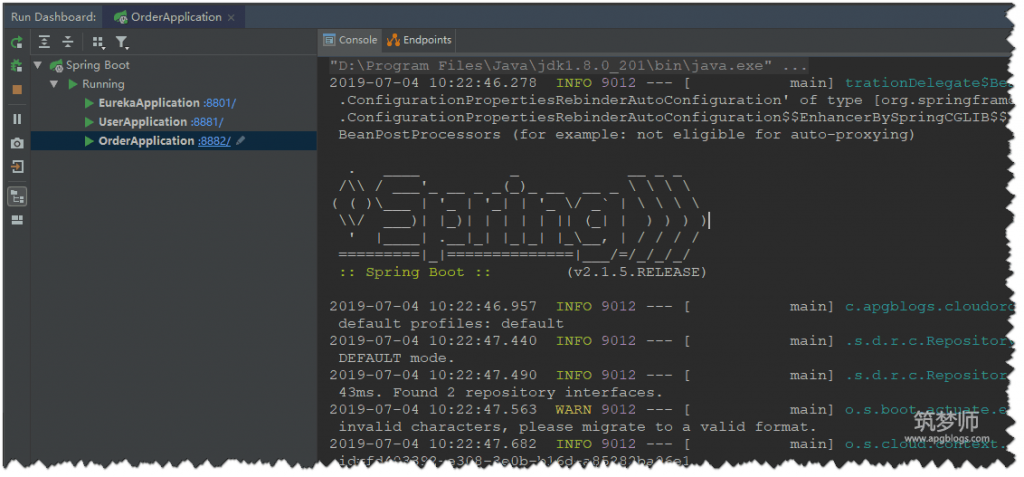
查看服务中心是否已经出现了这两个微服务
出现那就说明注册成功了
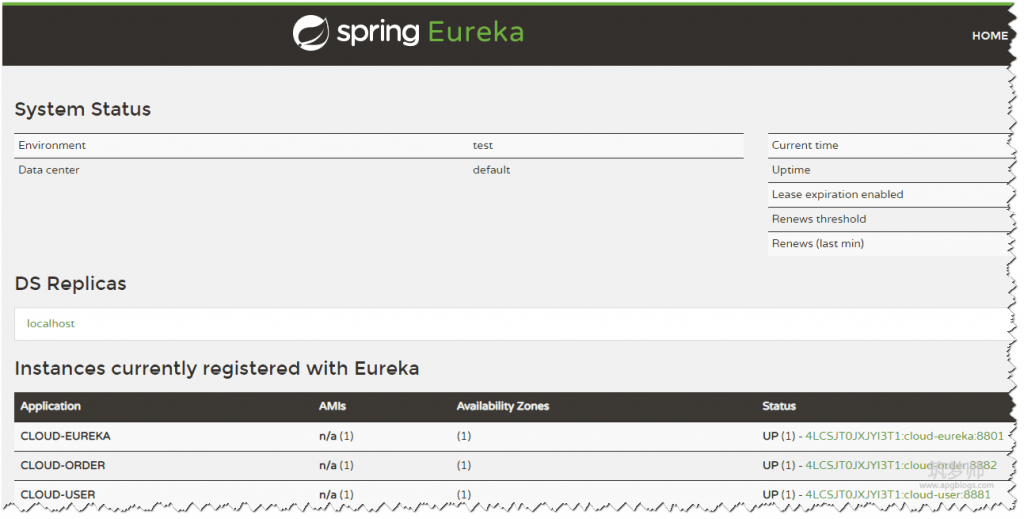
8、访问并测试订单微服务关联保存和关联查询
用postman访问订单保存接口
关联保存成功,可以到数据库查看是否写入成功了
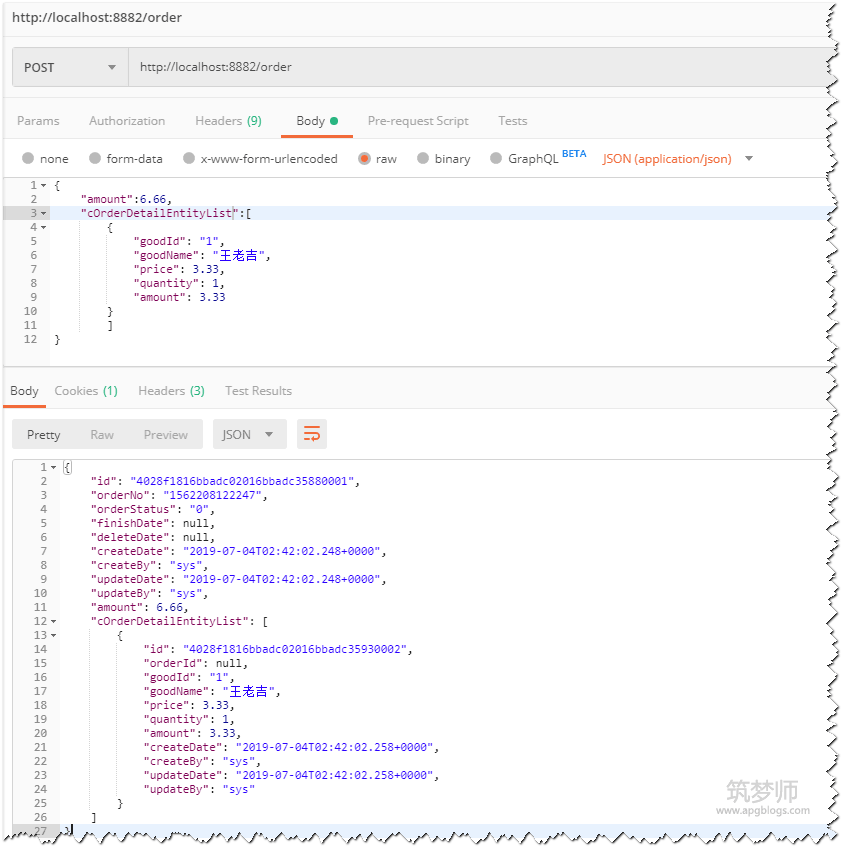
测试关联查询,用刚刚保存成功生成Id查询
可以看到查询成功了,那说明我们的接口写的没问题
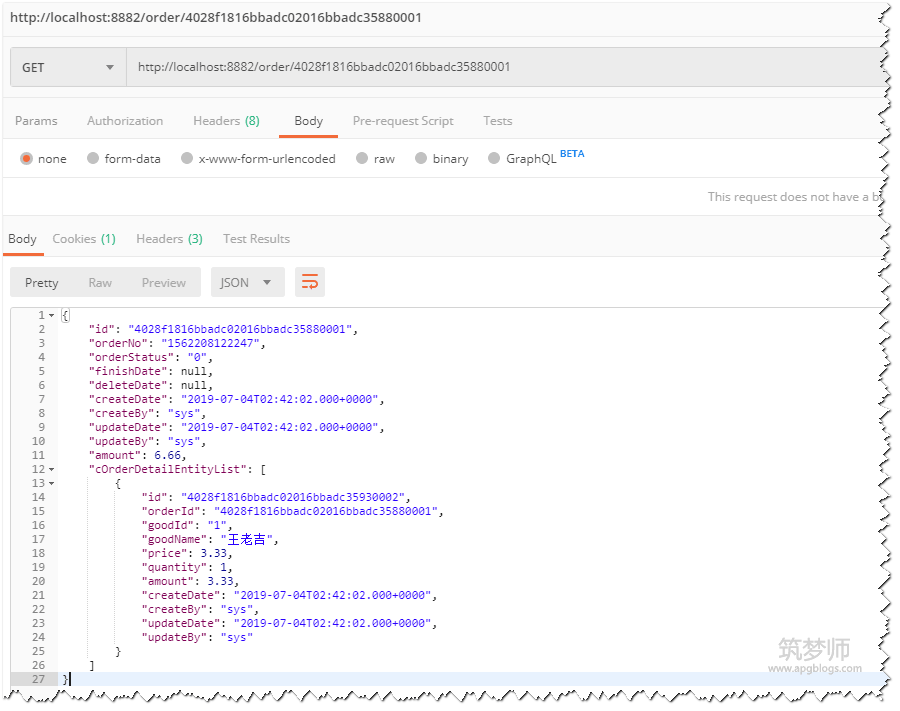
9、文章源码地址
至此订单微服务就已经构建好了,下一节继续创建商品微服务